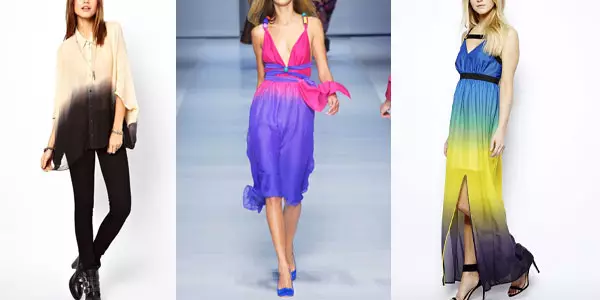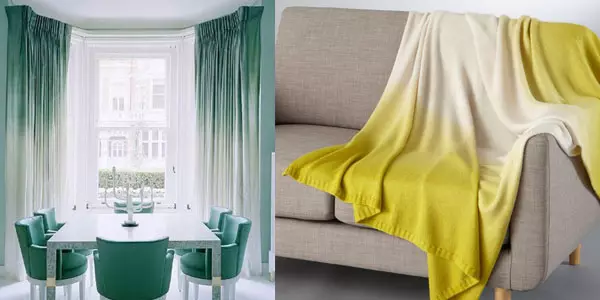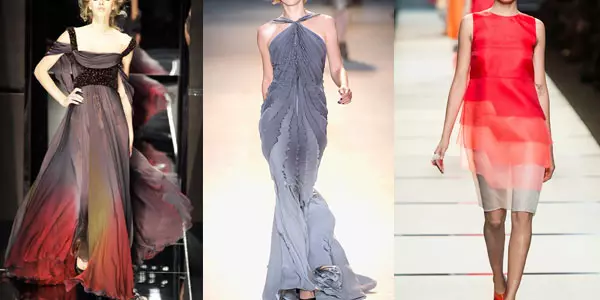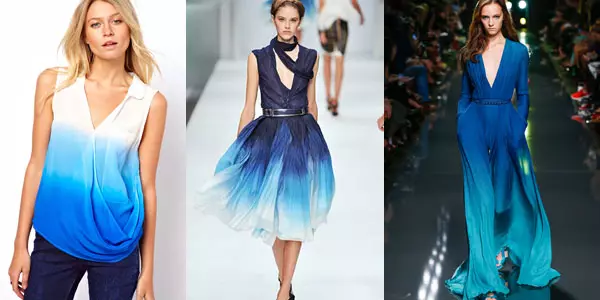The technique of gradation, or a smooth transition of the same color to another, was well known to the painters still centuries ago. In the fashion industry, such an optical effect is called degradation, and the widespread use of such materials began relatively recently. The gradual transition of one shade in the other is most often used in the tissues, of which the most common gentle and air chiffon degrad, as well as for materials such as leather and fur. This fashionable reception is used not only in clothing of various purposes, but also for home textiles, shoes, accessories, in nail design, etc.
History and trends
The origins of the fashion on the fabric with an unequal tint lie at the end of the sixties of the last century and are associated with various youth subcultures of that period. Hipsters, hipsters, punks wore jeans, and style rules demanded that they were shameful and pronounced. Such an effect, imitating scuffs, thickened or burning color in the sun, began to create specially. At first, jeans were whiten at home (legendary "vares"), then a denim fabric with fragments that change the shade from dark blue to whiten, began to be produced in an industrial way. Such things entered the mass fashion, the main bursts of which fell into the seventies and nineties.

Fashionable designers did not stand aside from this process and began to apply the effect of changing the shade not only to denim clothing, but also to other items of wardrobe. Tonal transitions were performed due to color, printed patterns, as well as the result of layering of multi-colored materials . The visual effect of a combination of smoothly moving one to another color zones allows designers to carry out the most creative ideas, and the owners of such outfits - successfully adjust the characteristics of the physique and look unusual and fashionable.
Article on the topic: Women's sleeveless knitted: Description with photos and video
Where is degraded?
Currently, flower transitions are a sign of style and originality, they are used in the clothes of any destination. Traditional chiffon degrad is ideal for light dresses - both ballroom and pleasure, knitwear with a changing color looks creative and elegant. In manual knitting, the degrad effect belongs to the most common and simple technological techniques, which practical needlewomen will be used to dispose of yarn residues.
Leading designers are constantly experimenting over this style. In addition to the traditional clarification of the main shades, transitions are used in the range of one colors, as well as between two different bright colors (for example, green and brown, neon and black). Parcel looks very original, leather fur in the style of degrad, as well as the color change is not top down, but from left to right, creating a fashionable asymmetry and an optically narrowing figure . Wide possibilities are overflows of color on bedspreads, curtains, life objects.

Color transitions in clothes allow you to highlight the most attractive features of the shape and gently disguise its disadvantages.
The traditional light top of the dress is ideal for a "pear" type figure, the dark shade at the top optically narrows the shoulders and expands the hips in the triangle figure. If there are dark zones along the waistline, the effect of "hourglass" is achieved even with the bodies of the "apple".
A wide role in the correction of the figure can play a scarf or a cape with color transitions, allowing to hide excess volumes and refreshing the face. For a complete figure, you should choose the fabrics of soft discreet shades with smooth transitions. In order for the degrad effect to be distorted and did not play a cruel joke in visual perception, such a dress should have a minimal number of details.

Degrad do it yourself
Modern textiles with gradient shades guarantees winning color combinations and a smooth nature of the transition, as well as dye strength. Of course, this applies only to products of authoritative manufacturers. At the same time, with sufficient skill, the transition effect can be obtained independently.
Degrad on silk:
Article on the topic: Elegant crochet tunics with a scheme and description
The most interesting combinations of shades are created in tissue painting technique. This requires special dyes that are applied to a brush or from a can, and, of course, artistic taste and skill. A simpler version is a stepped painting of a piece of fabric or a finished product. The source material must be monophonic, light and clean. The first experience for beginners is recommended to be carried out on a white knitted shirt.

To create "home degrad" it is necessary to choose a resistant dye of a suitable shade, the best aniline. The solution is prepared according to the instructions in the vessel of sufficient volume and width. The height of individual tint zones is better to pre-mark stitches on both sides. The top of the product is sewn to a wooden rail, the T-shirt is enough just to wear on it.
Bringing the solution to the required temperature, the fabric is lowered to it until the top level for a few seconds. So that the border is not cutting, the rail is horizontally raised to a small height and lowered. Then the product is lifted to the next zone and do the same manipulations with the following zone, increasing the exposure time with the solution. The lowest part must be in the dye all the time specified in the coloring instructions. After that, the fabric is well flashed in cold water, adding vinegar. With the right choice of dye, such a thing will endure a plurality of washes without losing its kind.
Fix the paint on the fabric:
